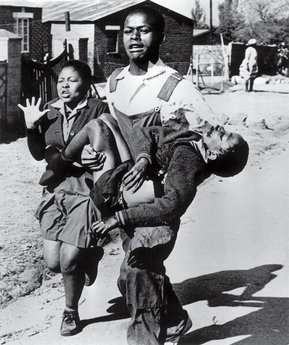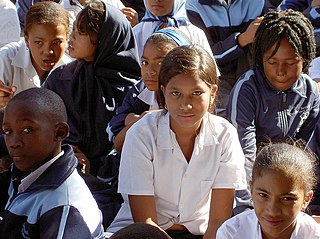Related Research Articles

South African English is the set of English language dialects native to South Africans.

The University of Fort Hare is a public university in Alice, Eastern Cape, South Africa.

A Bantustan was a territory that the National Party administration of South Africa set aside for black inhabitants of South Africa and South West Africa, as a part of its policy of apartheid.

Hendrik Frensch Verwoerd, also known as H. F. Verwoerd, was a South African politician, scholar, and newspaper editor who was Prime Minister of South Africa and is commonly regarded as the architect of apartheid and nicknamed the "father of apartheid". Verwoerd played a significant role in socially engineering apartheid, the country's system of institutionalized racial segregation and white supremacy, and implementing its policies, as Minister of Native Affairs (1950–1958) and then as prime minister (1958–1966). Furthermore, Verwoerd played a vital role in helping the far-right National Party come to power in 1948, serving as their political strategist and propagandist, becoming party leader upon his premiership. He was the Union of South Africa's last prime minister, from 1958 to 1961, when he proclaimed the founding of the Republic of South Africa, remaining its prime minister until his assassination in 1966.

The National Party, also known as the Nationalist Party, was a political party in South Africa from 1914 to 1997, which was responsible for the implementation of apartheid rule. The party was an Afrikaner ethnic nationalist party, which initially promoted the interests of Afrikaners but later became a stalwart promoter and enactor of white supremacy, for which it is best known. It first became the governing party of the country in 1924. It merged with its rival, the SAP, during the Great Depression, and a splinter faction became the official opposition during World War II and returned to power. With the National Party governing South Africa from 4 June 1948 until 9 May 1994, the country for the bulk of this time was only a de jure or partial democracy, as from 1958 onwards non-white people were barred from voting. In 1990, it began to style itself as simply a South African civic nationalist party, and after the fall of apartheid in 1994, attempted to become a moderate conservative one. The party's reputation was damaged irreparably by perpetrating apartheid, and it rebranded itself as the New National Party in 1997 before eventually dissolving in 2005.
The Department of Bantu Education was an organisation created by the National Party government of South Africa in 1953. The Bantu Education Act, 1953 provided the legislative framework for this department.

Apartheid was a system of institutionalised racial segregation that existed in South Africa and South West Africa from 1948 to the early 1990s. Apartheid was characterised by an authoritarian political culture based on baasskap, which ensured that South Africa was dominated politically, socially, and economically by the nation's minority white population. In this minoritarian system, there was social stratification, where white citizens had the highest status, followed by Indians and Coloureds, then Black Africans. The economic legacy and social effects of apartheid continue to the present day, particularly inequality.

The Soweto uprising was a series of demonstrations and protests led by black school children in South Africa during apartheid that began on the morning of 16 June 1976.

Educational Systems in S.A
The National Union of South African Students (NUSAS) was an important force for liberalism and later radicalism in South African student anti-apartheid politics. Its mottos included non-racialism and non-sexism.
The system of racial segregation and oppression in South Africa known as apartheid was implemented and enforced by many acts and other laws. This legislation served to institutionalize racial discrimination and the dominance by white people over people of other races. While the bulk of this legislation was enacted after the election of the National Party government in 1948, it was preceded by discriminatory legislation enacted under earlier British and Afrikaner governments. Apartheid is distinguished from segregation in other countries by the systematic way in which it was formalized in law.

Internal resistance to apartheid in South Africa originated from several independent sectors of South African society and took forms ranging from social movements and passive resistance to guerrilla warfare. Mass action against the ruling National Party (NP) government, coupled with South Africa's growing international isolation and economic sanctions, were instrumental in leading to negotiations to end apartheid, which began formally in 1990 and ended with South Africa's first multiracial elections under a universal franchise in 1994.

The Native Labour Act, 1953 was a South African law that formed part of the apartheid system of racial segregation in South Africa. The effect of the law was to prohibit strike action by black Africans.
Werner Willi Max Eiselen (1899–1977) was a South African anthropologist and linguist fluent in a number of African languages. He was an ally and associate of Hendrik Verwoerd, the Minister of Native Affairs from 1950 to 1958 and the Prime Minister of South Africa from 1958 to 1966. He led the Eiselen Commission, an advisory board that investigated native education and formed the basis of the Bantu Education Act of 1953 which moved control of education of South Africa's blacks from missionary schools to local government control. It also made starting a "Bantu" school without permission and registration from the government illegal.

The Tomlinson Report was a 1954 report released by the Commission for the Socioeconomic Development of the Bantu Areas, known as the Tomlinson Commission, that was commissioned by the South African government to study the economic viability of the native reserves. These reserves were intended to serve as the homelands for the black population. The report is named for Frederick R. Tomlinson, professor of agricultural economics at the University of Pretoria. Tomlinson chaired the ten-person commission, which was established in 1950. The Tomlinson Report found that the reserves were incapable of containing South Africa's black population without significant state investment. However, Hendrik Verwoerd, Minister of Native Affairs, rejected several recommendations in the report. While both Verwoerd and the Tomlinson Commission believed in "separate development" for the reserves, Verwoerd did not want to end economic interdependence between the reserves and industries in white-controlled areas. The government would go on to pass legislation to restrict the movement of blacks who lived in the reserves to white-controlled areas.

The apartheid regime in South Africa began in 1948 and lasted until 1994. It involved a system of institutionalized racial segregation and white supremacy, and placed all political power in the hands of a white minority. Opposition to apartheid manifested in a variety of ways, including boycotts, non-violent protests, and armed resistance. Music played a large role in the movement against apartheid within South Africa, as well as in international opposition to apartheid. The impacts of songs opposing apartheid included raising awareness, generating support for the movement against apartheid, building unity within this movement, and "presenting an alternative vision of culture in a future democratic South Africa."
"Meadowlands" is an anti-apartheid song composed in 1956 by Strike Vilakazi. It was written in reaction to the forced relocation of black South Africans from Sophiatown, to the new township of Meadowlands. The song was popularised by a number of musicians, including Dorothy Masuka and Miriam Makeba, and became an anthem of the movement against apartheid.
The Professional Educators' Union (PEU) is a trade union representing education workers in South Africa.
Nathaniel Impey Honono, also known as Tshutsha, was a prominent South African activist. He was a graduate of the University of Fort Hare and became the president of the Cape African Teachers Association (CATA) in 1945, where he used his influence to oppose government education policies. Honono was a dedicated member of various organizations, including the Non-European Unity Movement (NEUM) and the All-African Convention. He worked closely with fellow activists like Isaac Bangani Tabata to advance the rights of marginalized communities and challenge apartheid policies. Honono's commitment extended to enduring repression, imprisonment without trial, and efforts to seek international recognition for the NEUM's anti-apartheid struggle.
Sibusisiwe Violet Makhanya, first black South African social worker
References
- ↑ Nadine L. Moore, Faculty of Humanities University of Pretoria (2015). "IN CLASS OF THEIR OWN: THE BANTU EDUCATION ACT (1953) REVISITED" (PDF).
- 1 2 3 4 Clark, Domini; Nancy L. Clark; William H. Worger (2004). South Africa - The Rise and Fall of Apartheid. Seminar Studies in History. Pearson Education Limited. pp. 48–52. ISBN 0-582-41437-7.
- ↑ Timeline of the University: 1959 Archived December 30, 2007, at the Wayback Machine . Official website of University of Fort Hare. Accessed 2007-12-03.
- 1 2 3 Byrnes, Rita M. (1996). South Africa: A Country Study. Washington: GPO for the Library of Congress.
- ↑ Giliomee H. (March 2009). "A Note on Bantu Education 1953-1970", South African Journal of Economics.
- ↑ Boddy-Evans, Alistair (18 January 2021). "The Afrikaans Medium Decree". ThoughtCo. Retrieved 30 August 2022.
- ↑ South Africa: Time Running Out : the Report of the Study Commission on U.S. Policy Toward Southern Africa. University of California Press. 15 September 1981. ISBN 9780520045477 . Retrieved 15 September 2017– via Google Books.
http://nmmu.ac.za/documents/mward/Bantu%20Education%20Act%201953.pdf%5B%5D